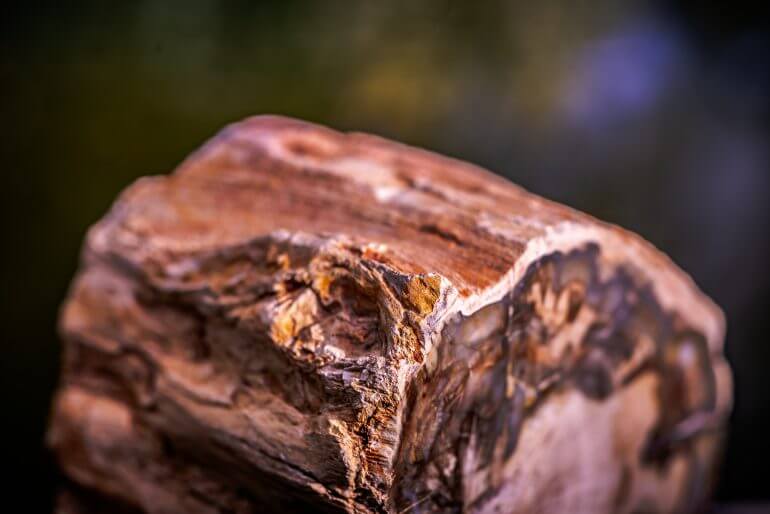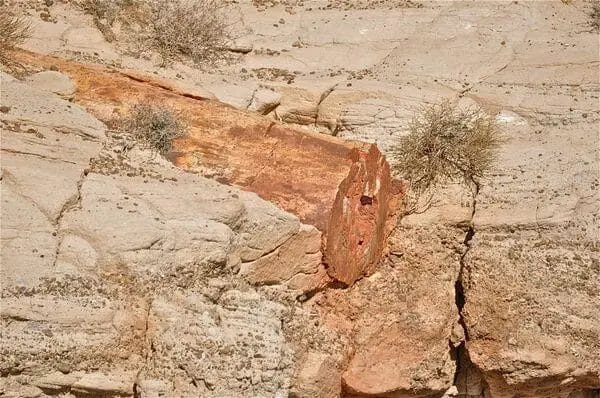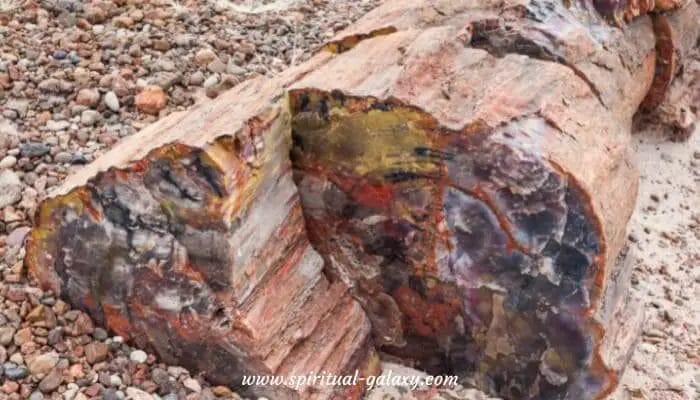Interested in learning how to make your own petrified wood? Look no further! Petrified wood is a fascinating process that occurs over millions of years, but with a few simple steps, you can create your own stunning pieces in a matter of weeks. In this guide, we will walk you through the process of transforming wood into beautiful petrified specimens using a mixture of water, minerals, and time. Get ready to unlock the secrets of nature’s incredible fossilization process and create your very own petrified wood masterpieces!

Preparing the Wood for Petrification
Petrified wood is a fascinating natural phenomenon that occurs when organic wood is transformed into stone over a long period of time. The process of petrification involves the replacement of the wood’s original organic materials with minerals, resulting in a remarkable preservation of the wood’s cellular structure. In order to successfully petrify wood, it is important to properly prepare the wood before beginning the petrification process.

Cleaning the Wood
The first step in preparing wood for petrification is to thoroughly clean it. This involves removing any dirt, debris, or loose bark from the surface of the wood. You can use a brush or a cloth to gently scrub away any dirt, being careful not to damage the wood in the process. It is important to remove as much of the organic matter as possible to ensure a successful petrification process.
Drying the Wood
After the wood has been cleaned, it should be allowed to dry completely. Moisture can interfere with the petrification process, so it is important to ensure that the wood is completely dry before proceeding. You can place the wood in a well-ventilated area or use a dehumidifier to speed up the drying process. It may take several weeks for the wood to dry fully, depending on its size and moisture content.
Stabilizing the Wood
Once the wood is dry, it is important to stabilize it to prevent any further degradation or warping. This can be done by applying a stabilizing solution to the wood. Stabilizing solutions are typically made from a combination of resin and solvent, which penetrate the wood and help to reinforce its structure. The solution should be applied evenly to all surfaces of the wood, allowing it to soak in and dry fully.
Sealing the Wood
After the wood has been stabilized, it should be sealed to protect it from moisture and other environmental factors. This can be done by applying a sealant or wood preservative to the surface of the wood. The sealant should be allowed to dry completely before proceeding with the petrification process.
Preparing the Petrification Solution
Once the wood has been cleaned, dried, stabilized, and sealed, it is ready to be immersed in the petrification solution. The petrification solution is typically a mixture of minerals and water, which will slowly replace the organic materials in the wood and transform it into stone. The specific composition of the petrification solution will depend on the desired outcome and the type of minerals available.
It is important to carefully follow the instructions for preparing the petrification solution, as the concentration and duration of the immersion can greatly impact the final result. The wood should be submerged in the solution for a sufficient amount of time to allow the minerals to fully penetrate the cellular structure of the wood. This process can take several weeks or even months, depending on the size and density of the wood.
In summary, preparing wood for petrification involves cleaning, drying, stabilizing, sealing, and immersing the wood in a petrification solution. By following these steps, you can increase the chances of successfully petrifying wood and creating a stunning piece of natural art.

Petrification Techniques and Methods
Petrification is the process of converting organic materials into stone-like substances. It has been used for various purposes throughout history, including preservation, art, and even mythology. In this section, we will explore some of the most common techniques and methods used in petrification.
1. Mineralization
Mineralization is a key technique used in petrification. It involves the replacement of organic materials with minerals, such as silica, calcite, or pyrite. This process occurs when the minerals in the surrounding environment infiltrate the organic material and gradually replace its cellular structure.
To achieve mineralization, several factors need to be considered, including the pH of the environment, temperature, and the composition of the minerals. Different minerals produce different colors and textures, resulting in unique petrified specimens.
2. Permineralization
Permineralization is a specific form of mineralization in which the organic material is preserved within the mineral structure. This occurs when the minerals fill the pores and spaces within the organic material, creating a detailed replica of the original specimen.
Permineralization is commonly seen in fossilization, where the minerals provide support and protection to delicate structures, such as plant cells or animal bones. This technique allows scientists to study the intricate details of ancient organisms.
3. Replacement
Replacement is another method used in petrification, which involves the complete substitution of the organic material with a different substance. This occurs when the original material dissolves and is replaced by minerals or other substances.
One example of replacement is petrified wood, where the organic material is replaced by minerals such as silica or opal. This process can occur over millions of years, resulting in the preservation of the wood’s original structure, but with a stony composition.
4. Impregnation
Impregnation is a technique in which a substance, such as resin or wax, is used to infiltrate and preserve the organic material. The substance fills the cells and voids within the material, providing support and preventing decay.
This method is commonly used in the preservation of plant specimens, particularly in botanical gardens or herbariums. It allows for long-term storage and study of plants without the risk of deterioration.
5. Casts and Molds
Casts and molds are techniques used to create replicas of organic materials through petrification. A mold is created by taking an impression of the original specimen, which is then filled with a casting material, such as plaster or resin.
This method is often used in paleontology to create replicas of dinosaur bones or other ancient fossils. It allows researchers to study and display these specimens without risking damage to the original materials.
6. Synthetic Petrification
Synthetic petrification is a relatively modern technique that involves the use of chemicals and processes to petrify organic materials. This technique is often used in art, where artists can create petrified versions of various objects, such as plants or even human bodies.
By carefully controlling the petrification process, synthetic petrification allows for the creation of unique and artistic pieces. It offers artists the ability to capture the beauty and essence of organic materials while preserving them indefinitely.
In summary, petrification techniques and methods have been used for centuries to preserve and study organic materials. From mineralization to synthetic petrification, each method offers its own unique approach to transforming organic substances into stone-like structures. Whether for scientific research, artistic expression, or historical preservation, petrification continues to be a fascinating process that allows us to explore the past and appreciate the beauty of nature.

Caring for Petrified Wood
Petrified wood is a fascinating and unique type of fossilized wood that has turned into stone over millions of years. It is a popular choice for collectors and enthusiasts due to its beautiful patterns and colors. However, to preserve its beauty and integrity, proper care and maintenance are essential. In this section, we will discuss some tips and guidelines for caring for petrified wood.
1. Cleaning
Regular cleaning is necessary to maintain the luster and appearance of petrified wood. It is important to note that petrified wood is porous, so using harsh chemicals or abrasive cleaners can damage its surface. Instead, it is recommended to use a soft cloth or brush with mild soap and water to gently remove any dust or dirt. Avoid scrubbing vigorously or using excessive water, as it can cause discoloration or erosion. After cleaning, make sure to thoroughly dry the wood to prevent moisture buildup.
2. Avoiding Direct Sunlight
Petrified wood can be sensitive to prolonged exposure to direct sunlight. UV rays can fade its vibrant colors and cause the wood to become brittle. To protect your petrified wood, it is advisable to display it away from windows or areas that receive direct sunlight. If you want to showcase your petrified wood outdoors, consider placing it in a shaded or covered area to minimize sun exposure.
3. Handling and Storage
When handling petrified wood, it is important to use caution and avoid dropping or mishandling it. Petrified wood can be heavy and fragile, so always lift and move it with care. If you need to store your petrified wood, choose a dry and stable environment. Extreme temperature fluctuations and high humidity can potentially damage the wood. Avoid storing it in basements, garages, or areas prone to moisture. Using padded or soft surfaces to cushion the wood during storage can help prevent any accidental damage.
4. Sealing
Sealing petrified wood can help protect its surface and enhance its natural beauty. Before sealing, ensure that the wood is clean and dry. There are various sealants available specifically designed for petrified wood. Follow the manufacturer’s instructions and apply the sealant evenly over the entire surface of the wood. This will help prevent stains, discoloration, and moisture absorption. It is recommended to reseal the wood periodically, especially if it is exposed to high humidity or heavy usage.
5. Display and Decor
Petrified wood can be displayed in various ways to showcase its unique characteristics. It can be a centerpiece on a coffee table, a bookshelf decoration, or even used as a paperweight. When using petrified wood as a decorative item, ensure that it is placed on stable and level surfaces to avoid any accidental falls. Additionally, consider using protective pads or coasters underneath to prevent scratching or damage to furniture surfaces.
6. Professional Restoration
If your petrified wood has sustained significant damage or deterioration, it is advisable to seek professional restoration services. Qualified experts can assess the condition of the wood and provide appropriate restoration techniques. Attempting DIY restoration methods without proper knowledge and experience may result in further damage. Therefore, it is best to consult professionals for any extensive restoration needs.
In summary, caring for petrified wood involves regular cleaning, avoiding direct sunlight, handling and storing with caution, sealing to protect the surface, displaying it appropriately, and seeking professional restoration if needed. By following these guidelines, you can ensure the longevity and beauty of your petrified wood collection.
Creative Uses for Petrified Wood
Petrified wood is a fascinating natural material that has been transformed into stone over millions of years. Its unique beauty and durability make it a popular choice for various creative projects. In this section, we will explore some creative uses for petrified wood that can add a touch of elegance and natural charm to your home or outdoor space.
1. Decorative Pieces
Petrified wood slices or chunks can be used as eye-catching decorative pieces. They can be displayed on shelves, mantels, or coffee tables to add a rustic and earthy element to any room. The intricate patterns and colors in the petrified wood make each piece truly unique and visually appealing.
2. Jewelry
Petrified wood can be incorporated into stunning jewelry pieces such as pendants, earrings, and bracelets. Its natural beauty and organic texture make it a sought-after material for jewelry designers. The rich earth tones and fossilized patterns create a one-of-a-kind accessory that can be cherished for a lifetime.
3. Furniture
Petrified wood can be transformed into striking furniture pieces that can become focal points in any living space. Coffee tables, side tables, or even dining tables made from petrified wood can add a touch of elegance and sophistication to your home. The natural colors and patterns of the petrified wood create an exquisite and eye-catching design.
4. Sculptures and Artwork
The unique textures and shapes of petrified wood make it an ideal material for sculpting and creating artwork. Artists can carve, shape, or assemble pieces of petrified wood to create stunning sculptures or wall art. The natural variations in color and pattern offer endless possibilities for artistic expression.
5. Garden Features
Petrified wood can be used to create unique and durable garden features. From stepping stones and garden benches to fountains and planters, petrified wood can add a touch of natural beauty to your outdoor space. Its weather-resistant nature ensures that these features will withstand the test of time.
| Pros | Cons |
|---|---|
| Unique and beautiful | Can be expensive |
| Durable and long-lasting | Requires proper care and maintenance |
| Versatile in design and usage | May be heavy and difficult to transport |
| Environmentally friendly | Limited availability |
In summary, petrified wood offers a plethora of creative uses that can enhance the aesthetics of your living spaces. Whether you choose to incorporate it into your home decor, jewelry, furniture, artwork, or garden features, petrified wood is guaranteed to add a touch of natural beauty and timeless elegance.
FAQs
1. How is petrified wood formed?
Petrified wood is formed when organic wood material is buried and preserved by minerals over a long period of time. As groundwater flows through the buried wood, it deposits minerals like silica, calcite, and iron oxides, replacing the original organic matter with stone-like minerals.
2. Can I make petrified wood at home?
No, it is not possible to make petrified wood at home. The natural process of petrification takes millions of years to occur, and it requires specific geological conditions to facilitate the replacement of organic material with minerals. However, you can purchase petrified wood specimens that have been naturally formed over time.
3. Where can I find petrified wood?
Petrified wood can be found in various locations around the world. Some popular places to find petrified wood include Arizona (USA), Madagascar, Indonesia, and the Petrified Forest National Park in Arizona. It is important to note that collecting petrified wood may be regulated, so it is advisable to check local laws and regulations before collecting specimens.
Conclusion:
In conclusion, learning how to make petrified wood can be a fascinating and rewarding experience. By understanding the natural process of petrification and recreating it with the right materials and techniques, you can transform ordinary wood into a beautiful and durable fossil-like material. Whether you are a hobbyist looking to create unique home decor pieces or a geology enthusiast exploring the wonders of ancient forests, making petrified wood allows you to connect with the Earth’s history and create something truly remarkable.
So, gather your supplies, follow the steps carefully, and embark on this exciting journey of creating your own petrified wood. Enjoy the transformation and the awe-inspiring beauty that this ancient process brings.